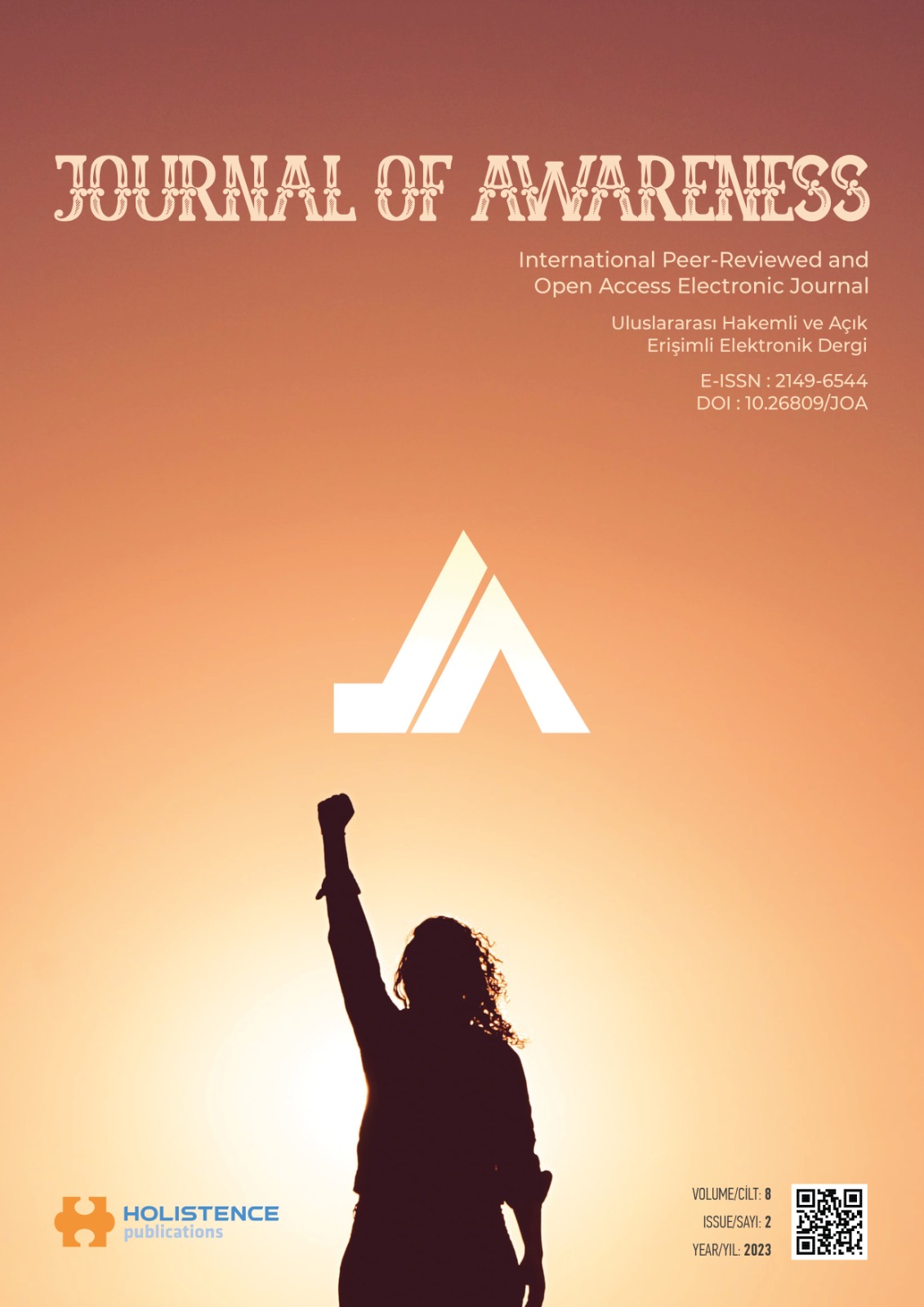Adolescent pregnancy in terms of adolescent rights: A retrospective study on adolescent giving births between 2015-2022 in a metropolitan hospital in Türkiye
DOI:
https://doi.org/10.26809/joa.2012Anahtar Kelimeler:
Adolescent- Adolescent pregnancy- Adolescent mother- Child mother- Adolescent RightsÖzet
Aim: Adolescent pregnancy refers to a pregnancy in a female who is younger than 19 year of age. Adolescent pregnancy can have a number of negative consequences for both the mother and the child, including increased risk of health complications, poor educational and economic outcomes, and social and emotional challenges. This study aims to provide regional data on the prevalence of adolescent pregnancy in Türkiye and to propose solutions to this problem
Methodolody: Pregnancies under the age of 19 which resulted in births gave birth in a public hospital that provides birth-specific service in one of the metropolitan areas within the borders of the Republic of Türkiye between 2015-2022 were retrospectively analysed. Detected pregnancies have been evaluated and analysed according to criteria such as age, nationality, and week of birth.
Results: In the sample subject to the research, between the years 2015-2022; 3174 adolescents under the age of 19 gave birth. Of these, 54% (N:1718) are Turkish nationals, 45% (N:1431) are Syrian nationals, and the remaining 1% (N:25) are other nationals. The average birth week is 36 weeks. The number of stillbirths is 88, of which 57% (N:50) are Syrian nationals and 42% (N:37) are Turkish nationals. While the number of adolescent pregnancies resulted in birth was 601 in 2015, it increased to 714 in 2016; It decreased to 157 in 2021.
Conclusion: Adolescent pregnancy is a significant problem in Türkiye and also common among Syrian refugees. Adolescent pregnancy can have a variety of negative consequences, including health risks for the mother and the baby, as well as social and economic challenges. They are less likely to complete their education, be employed, earn higher wages, and be happily married; they are more likely to have larger families and live in poverty. It is necessary to conduct training programs and adopt decisive strategies. These actions are the most fundamental key to protect the human rights of adolescents.
İndirmeler
Referanslar
ALUGA D. & OKOLIE EA. (2021). Socioeconomic determinants of teenage pregnancy and early motherhood in the United Kingdom: A perspective. Health Promot Perspect. 2021 Dec 19;11(4):426-429. doi: 10.34172/hpp.2021.52. PMID: 35079585; PMCID: PMC8767081.
AMBIA AM, PRUSZYNSKI JE, FAIRCHILD E, MCINTIRE DD. & NELSON DB. (2022). Perinatal outcomes of young adolescent pregnancies in an urban inner city. Am J Obstet Gynecol MFM. 2022 Dec 23;5(3):100843. doi: 10.1016/j.ajogmf.2022.100843. Epub ahead of print. PMID: 36572108. Accessed on 28.01.2023)
AMOADU M, ANSAH EW, ASSOPIAH P, ACQUAH P, ANSAH JE, BERCHIE E, HAGAN D & AMOAH E. (2022). Socio-cultural factors influencing adolescentpregnancy in Ghana: a scoping review. BMC Pregnancy Childbirth. 2022 Nov 11;22(1):834. DOI: 10.1186/s12884-022-05172-2. PMID: 36368956; PMCID: PMC9652868.
CHANDRA-MOULI V & AKWARA E. (2020). Improving access to and use of contraception by adolescents: What progress has been made, what lessons have been learnt, and what are the implications for action? Best Pract Res Clin Obstet Gynaecol. 2020 Jul;66:107-118
COLES MS, MAKINO KK & STANWOOD NL. (2011).Contraceptive experiences among adolescents who experience unintended birth. Contraception. 2011 Dec;84(6):578-584. doi: 10.1016/j.contraception.2011.03.008. Epub 2011 Apr 29. PMID: 22078186; PMCID: PMC4266371.
DARROCH J, WOOG V, BANKOLE A & ASHFORD LS. (2016). Adding it up: Costs and benefits of meeting the contraceptive needs of adolescents. New York: Guttmacher Institute; 2016. https://www.guttmacher.org/report/adding-it-meeting-contraceptive-needs-of-adolescents (Accessed on 18.08.2022)
DIR AL, HULVERSHORN LA & AALSMA MC. (2019) The Role of Pregnancy Concerns in the Relationship between Substance Use and Unprotected Sex among Adolescents. Subst Use Misuse. 2019;54(7):1060-1066. DOI: 10.1080/10826084.2018.1524912. Epub 2019 Apr 8. PMID: 30957674; PMCID: PMC6498425
FINER L. & HENSHAW S. (2006). Disparities in rates of unintended pregnancy in the United States, 1994 and 2001. Perspect Sex Reprod Health. 2006;38:90–96.
HAYES, CD. (1987). National Research Council (US) Panel on Adolescent Pregnancy and Childbearing. Risking the Future: Adolescent Sexuality, Pregnancy, and Childbearing, Volume II: Working Papers and Statistical Appendices. Hofferth SL, Hayes CD, editors. Washington (DC): National Academies Press (US); 1987. Chapter 9. PMID: 25032470.
KARATAŞLI V, KANMAZ AG, İNAN AH, BUDAK A. & BEYAN E. (2019). Maternal and neonatal outcomes of adolescent pregnancy. (2019) J Gynecol Obstet Hum Reprod. 2019 May;48(5):347-350. DOI: 10.1016/j.jogoh.2019.02.011. Epub 2019 Feb 19. PMID: 30794955.
KILIÇÇEKER, R. (2019). Acil servise başvuran adölesan gebelerin retrospektif incelenmesi/ A retrospective study of pregnant adolescents admitted to the emergency department (Master’s thesis, Mersün Ümniversitesi Sağlık Bilimleri Enstitüsü / Mersin University, Health Sciences Institute).
MERAL O., ŞENER A. & ŞEN T. (2021). Bir Eğitim ve Araştırma Hastanesine Başvuran Adölesan Gebelerin Tıbbi, Sosyal ve Hukuki Açıdan İncelenmesi. (2021) Medical Records. 2021; 3(2): 73-79.
NEAL S, MATTHEWS Z, FROST M, et al. (2015). Childbearing in adolescents aged 12–15 years in low resource countries: a neglected issue. New estimates from demographic and household surveys in 42 countries. Acta Obstet Gynecol Scand 2012;91: 1114–18. Every Woman Every Child. The Global Strategy for Women`s, Children`s and Adolescents` Health (2016-2030). Geneva: Every Woman Every Child, 2015.
PARRA-PINGEL PE, QUISIGUIÑA-AVELLÁN LA, HIDALGO L, CHEDRAUI P. & PÉREZ-LÓPEZ FR. (2017). Pregnancy outcomes in younger and older adolescent mothers with severe preeclampsia. Adolesc Health Med Ther. 2017 Jun 6;8:81-86. DOI: 10.2147/AHMT.S131050. PMID: 28652838; PMCID: PMC5476435.
POLAT, O. & REVA, Z. (2019). Legal Dimension of Child Marriages in Turkey: Compared with the Eastern Europe and Middle East Countries. International Journal of Research – Granthaalayah, Vol.7 (Iss.4): April 2019, ISSN- 2350-0530(O), ISSN- 2394-3629(P).
RAJ A. & BOEHMER U. (2013). Girl child marriage and its association with national rates of HIV, maternal health, and infant mortality across 97 countries. Violence Against Women. 2013 Apr;19(4):536-551. DOI: 10.1177/1077801213487747. Epub 2013 May 22. PMID:
SHREFFLER KM, TIEMEYER S. & COX RB JR. (2021). Trauma exposure and adolescent attitudes toward having a baby: An exploratory survey. Contracept X. 2021 Jan 29;3:100058. DOI: 10.1016/j.conx.2021.100058. PMID: 33665605; PMCID: PMC7907236
STEVENS-SIMON, C., & MCANARNEY, E. R. (1996). Adolescent pregnancy. In R. J. DiClemente, W. B. Hansen, & L. E. Ponton (Eds.), Handbook of adolescent health risk behavior (pp. 313–332). Plenum Press. https://doi.org/10.1007/978-1-4899-0203-0_12
TAPERT SF, AARONS GA, SEDLAR GR, & BROWN SA. (2001). Adolescent substance use and sexual risk-taking behavior. Journal of Adolescent Health, 28, 181–189. DOI: 10.1007/s11065-010-9146-6.
TurkStat (2021) 2020 Yılı Birth Statistics, 18 May 2022, V: 37229.
TurkStat (2022) 2021 Yılı Birth Statistics, 2 May 2022, V: 45547.
UNICEF (2018 Press Release, New York, 6 March 2018. https://www.unicef.org/eca/press-releases/25-million-child-marriages-prevented (Accessed on 18.08.2022)
WHO (2004). Adolescent pregnancy. Issues in adolescent health and development. Available online. Geneva, Switzerland: WHO; 2004. http://whqlibdoc.who.int/publications/2004/9241591455_eng.pdf. (Accessed on 18.08.2022)
WHO (2011) Preventing early pregnancy and poor reproductive outcomes among adolescents in developing countries. Geneva: 2011.
WHO (2016). Global health estimates 2015: deaths by cause, age, sex, by country and by region, 2000–2015. Geneva.
WHO(2021). https://www.who.int/news-room/fact-sheets/detail/maternal-mortality. Accessed on 18.08.2022)
WHO(2022a). Adolescent health. https://www.who.int/health-topics/adolescent-health#tab=tab_1 (Accessed on 18.08.2022)
WHO(2022b). Preterm birth. https://www.who.int/news-room/fact-sheets/detail/preterm-birth#:~:-text=Pre term%20is%20defined%20as%20babies,preterm%20(28%20to%2032%20weeks) (Accessed on 18.08.2022)
WHO, UNICEF, UNFPA, World Bank Group and the United Nations Population Division. (2015) Trends in maternal mortality: 1990 to 2015: Estimates by WHO,
UNICEF, UNFPA, World Bank Group and the United Nations Population Division. Geneva: WHO; 2015. Filippi V, Chou D, Ronsmans C, et al. Levels and Causes of Maternal Mortality and Morbidity. In: Black RE, Laxminarayan R, Temmerman M, et al., editors. Reproductive, Maternal, Newborn, and Child Health: Disease Control Priorities, Third Edition (Volume 2). Washington (DC): The International Bank for Reconstruction and Development / The World Bank; 2016 Apr 5. Chapter 3.)
YAKIT E. & COŞKUN A. (2014). The reality of child marriages in terms of society: The responsibility of the nurse and midwife / Toplumsal açıdan çocuk yaşta evlilikler gerçeği: Hemşire ve ebenin sorumluluğu. Journal of Education and Research in Nursing / Hemşirelikte Eğitim ve Araştırma Dergisi, 11(3), 3-10.
ZHANG J, MEIKLE S. & TRUMBLE A. (2003). Severe maternal morbidity associated with hypertensive disorders in pregnancy in the United States. Hypertens Pregnancy. 2003;22(2):203–212
İndir
Yayınlanmış
Nasıl Atıf Yapılır
Sayı
Bölüm
Lisans
Telif Hakkı (c) 2023 Holistence Publications

Bu çalışma Creative Commons Attribution 4.0 International License ile lisanslanmıştır.
Yazarlar, makale Journal of Awareness’de yayınlanmak üzere kabul edildiğinde.makalenin içeriğindeki tüm telif haklarını, Rating Academy Ar-Ge Yazılım Yayıncılık Eğitim Danışmanlık ve Organizasyon Ticaret Ltd. Şti’ne devrederler. Yazarlar, patent hakları gibi telif hakkı dışındaki tüm mülkiyet haklarını saklı tutar.
Bu makalede yazar olarak listelenen herkes çalışmaya önemli, doğrudan, entelektüel katkılar yapmış olmalı ve bunun için kamu sorumluluğu almalıdır.
Bu makale daha once yayınlanmamış ve başka dergilerde yayınlanmak üzere gönderilmemiştir.











